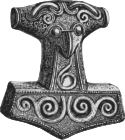- Nine Daughters of Ægir
-
 Ægir and his daughters brew ale in a large pot..
Ægir and his daughters brew ale in a large pot..
The Daughters of Ægir are the nine daughters of Ægir and Rán, a giant and goddess who both represent the sea in Norse mythology. Their names are poetic terms for different characteristics of ocean waves.
In the Skáldskaparmál section of Snorri Sturluson's Prose Edda the names of Ægir's daughters are recorded:
- The daughters of Ægir and Rán are nine, and their names are recorded before: Himinglæva, Dúfa, Blódughadda, Hefring, Udr, Hrönn, Bylgja, Dröfn, Kólga. - Brodeur's translation
Brodeur gives the following translations of the names:
- Himinglæva - That through which one can see the heavens (a reference to the transparency of water).
- Dúfa - The Pitching One.
- Blóðughadda - Bloody-Hair (a reference to red sea foam).
- Hefring - Riser.
- Uðr (or Unn) - Frothing Wave.
- Hrönn - Welling Wave.
- Bylgja - Billow.
- Dröfn - Foam-Fleck (or "Comber" according to Faulkes).
- Kólga - Cool Wave.
Contents
Prose Edda
Snorri lists the nine daughters twice in the Prose Edda but in one instance he replaces Dröfn with Bára. He also includes both Unn and Hrönn in a list of names of rivers.
In Skáldskaparmál, Snorri quotes a verse from the 12th century skald Einarr Skúlason in reference to Himinglaeva who "stirs up the roar of the sea against the brave" and who also, according to Háttatal, "strokes the high planks".[1]
Also quoted by Snorri is the Nordrsetudrapa by the poet Svein:
- "When hard gusts from the white mountain range teased apart and wove together the storm-happy daughters of Ægir, bred on frost."
In addition, he quotes the Icelandic poet Snæbjorn who refers to them as the "nine skerry-brides".
Poetic Edda
In stanza 28 of Grímnismál, part of the Poetic Edda, Hrönn is again included in a list of names of rivers enumerated during the revelatory visions of Odin.
In the poem Helgakviða Hundingsbana I (First Poem of Helgi Hundingsbani), stanza 28 describes Helgi's ship cutting through the waves:
- "Then it could be heard: they'd met together,
- the sister of Kolga and the longships,
- as mountains or surf might break asunder."
Stanza 29 includes a reference to the (singular) daughter of Ægir:
- "Helgi ordered the high sail to be set,
- his crew did not fail at the meeting of the waves,
- when Ægir's terrible daughter
- wanted to capsize the stay-bridled wave-horse [ship]"[2]
A reference to Ægir's daughter Uðr appears in Helgakviða Hundingsbana II, where the Valkyrie Sigrún puts a curse on her brother Dagr for having murdered her husband Helgi Hundingsbane in spite of the fact that he had sworn a holy oath of allegiance to Helgi on "Uð's ice cold stone" (unnarsteini):
- "Þik skyli allir
- eiðar bíta,
- þeir er Helga
- hafðir unna
- at inu ljósa
- Leiftrar vatni
- ok at úrsvölum
- Unnarsteini."[3]
- "Now may every
- oath thee bite
- That with Helgi
- sworn thou hast,
- By the water
- bright of Leipt,
- And the ice-cold
- stone of Uth."[4]
Theories
It has been noted by scholars including John Lindow[5] and Carolyne Larrington[2] that the daughters of Ægir and Rán are often thought to be the nine mothers of Heimdall, who are all said to be sisters according to both Snorri in Gylfaginning and a surviving fragment of the poem Heimdalargaldr. However, in the poem Hyndluljóð (Lay of Hyndla) the nine giantess mothers of Heimdall have different names including Gjálp and Greip and Járnsaxa which are known from other myths and are not specifically mentioned as sisters in the poem. Thus, this theory has remained speculative.
Notes and references
- ^ Faulkes, Anthony (transl. and ed.) (1987). Edda (Snorri Sturluson). Everyman. ISBN 0-460-87616-3
- ^ a b Larrington, Carolyne (transl. and ed.) (1996). The Poetic Edda. Oxford World's Classics. ISBN 0-19-283946-2
- ^ Völsungakviða in forna (Helgakviða Hundingsbana II) at «Norrøne Tekster og Kvad», Norway.
- ^ Translation by Bellows.
- ^ Lindow, John (2001). Norse Mythology. Oxford University Press. ISBN 0195153820.
Norse paganism Deities,
heroes,
and figuresOthersAsk and Embla · Dís (Norns · Valkyries) · Dwarf · Einherjar · Elves (Light elves · Dark elves) · Fenrir · Hel · Jörmungandr · Jötunn · Sigurd · Völundr · Vættir
Locations Asgard · Bifröst · Fólkvangr · Ginnungagap · Hel · Jötunheimr · Midgard · Múspellsheimr · Niflheim · Valhalla · Vígríðr · Wells (Mímisbrunnr · Hvergelmir · Urðarbrunnr) · YggdrasilEvents Sources Society See also Categories:- Jötnar
Wikimedia Foundation. 2010.

